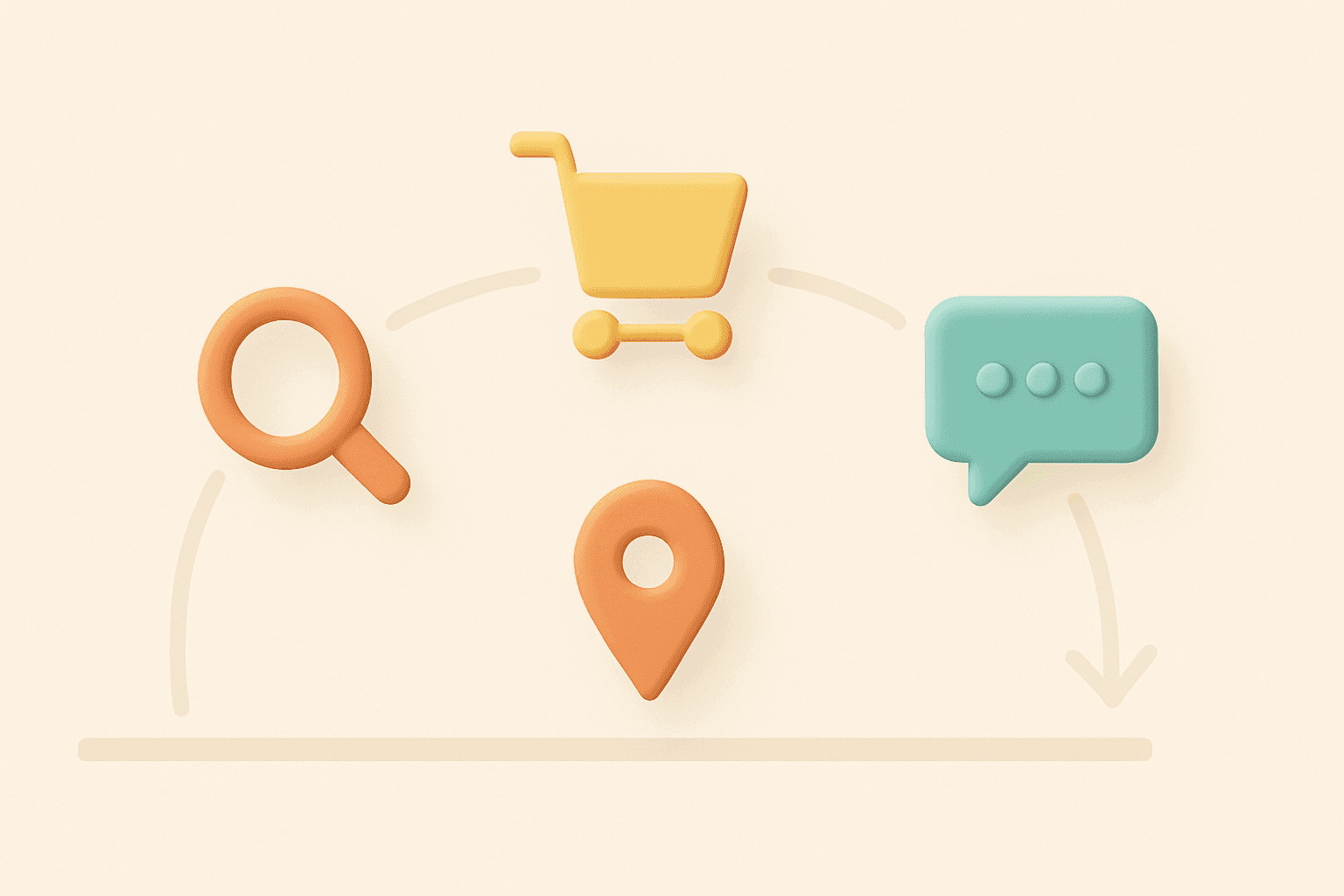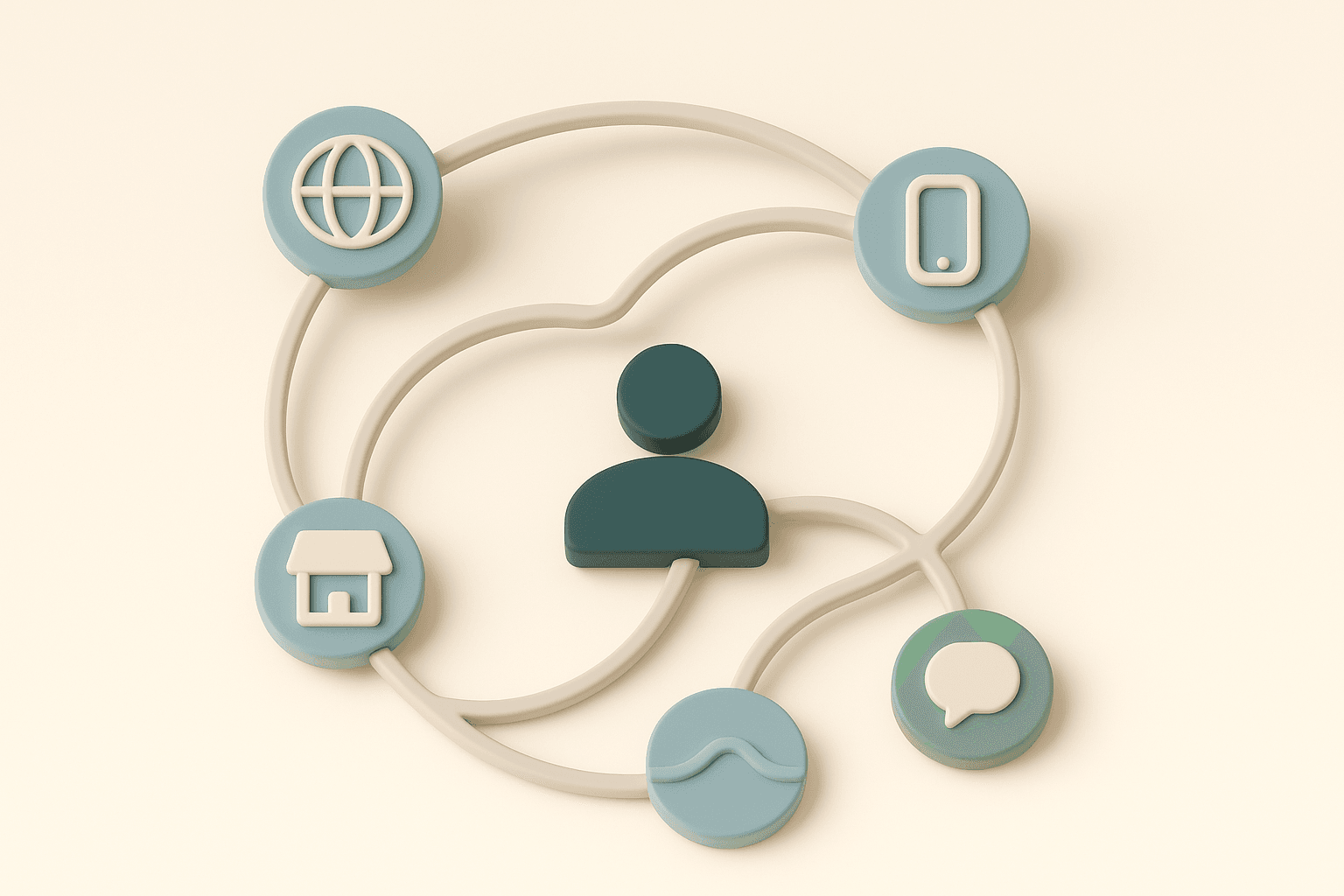Best Omnichannel Commerce Platforms (2025 Comparison)
As enterprise retailers expand across regions, channels, and fulfillment models, the challenge is no longer selling everywhere — it’s orchestrating everything. That’s where an omnichannel commerce platform becomes essential: it enables brands to unify systems, data, and experiences across physical and digital touchpoints.
A 2024 study by BetterCommerce found that retailers using omnichannel strategies are seeing up to a 287% increase in purchase rates compared to single-channel approaches. But not all platforms are built to deliver this level of integration and performance.
In this guide, we’ll walk through the architecture of a modern omnichannel stack, compare leading enterprise platforms like Shopify Plus, BigCommerce, and SAP Commerce Cloud, and provide decision frameworks to help you choose the right platform for your business.
What is an Omnichannel Commerce Platform?
An omnichannel commerce platform is a unified system that connects all customer touchpoints — online, in-store, mobile, and backend — into a single operational and experience layer. Unlike multichannel models where systems function in silos, omnichannel platforms ensure that every customer action updates in real time across all systems.
This real-time orchestration lets brands meet customer expectations for continuity — whether they’re switching devices mid-purchase, walking into a store post-chat, or expecting loyalty rewards to sync across touchpoints.
| Feature | Multi-channel | Omnichannel |
|---|---|---|
| Data Flow | Disconnected | Unified |
| Customer View | Fragmented | Centralized |
| Example | Email, store, app run independently | Cart built on app, purchased in-store, loyalty synced |
| Business Impact | Channel competition, inconsistent CX | Higher retention, cross-channel efficiency |
Core Systems Integrated in Omnichannel Platforms:
-
POS (Point of Sale) – Syncs in-store transactions with online profiles and inventory.
-
ERP (Enterprise Resource Planning) – Maintains inventory, supplier, and order consistency across locations.
-
CRM (Customer Relationship Management) – Centralizes customer data across channels for personalization.
-
OMS (Order Management System) – Enables cross-channel order processing (e.g., BOPIS, BORIS).
-
WMS (Warehouse Management System) – Connects stock levels with ecommerce front-end and POS in real-time.
For example, a beauty retailer using Shopify Plus and Gorgias might let a customer begin a skincare routine quiz online, receive tailored product suggestions via email, check local stock, and complete the purchase in-store — all while earning unified loyalty rewards.
Types of Omnichannel Commerce Tools (and When to Use Each One)
A successful omnichannel strategy requires a suite of specialized tools, each category serving distinct needs and uniquely delivering seamless customer experiences. Here's an overview of core tool categories, focusing on their unique capabilities.
To understand how these tools interact, here’s a visual breakdown of a typical omnichannel commerce stack:
🧱 Omnichannel Stack: System Layers and Interdependencies
| Layer | Function | Data Dependencies |
|---|---|---|
| 🟣 Marketing Platforms | Orchestrate email, SMS, and ad campaigns across customer journeys | Pulls from CRM, PIM, and commerce |
| 🔵 Customer Support Tools | Centralize interactions (chat, email, social) into a single resolution view | Pulls from CRM, OMS |
| 🟢 Commerce Platforms | Core engine for transactions, catalog, and checkout | Integrates with OMS, PIM, CRM |
| 🟠 OMS (Fulfillment) | Stock routing, shipping logic, and order orchestration | Feeds commerce + support with availability |
| 🟡 PIM (Product Catalog) | Central source for enriched product info across all channels | Powers listings, marketing, and CX |
1. Commerce Platforms (Core Transaction Layer)
At the heart of any omnichannel strategy is the commerce platform. These systems power the core transaction engine and manage product catalogs, customer data, and checkout logic across all channels — from web and mobile to marketplaces and in-store.
Enterprise-grade platforms like Salesforce Commerce Cloud are engineered for complex B2B operations with deep integration and governance needs. In contrast, Shopify Plus and BigCommerce Enterprise serve fast-scaling D2C brands looking for quicker go-to-market timelines, with built-in support for multi-region catalogs, social commerce, and direct-to-consumer storefronts.
Most brands consider upgrading to an enterprise-grade platform when they:
-
Operate across 3+ sales channels
-
Manage multi-country logistics or currencies
-
Cross 1,000+ SKUs or require advanced pricing logic
These platforms act as the operational core of your omnichannel stack — orchestrating catalogs, orders, promotions, and customer data across the layers above and below.
Ideal Users: Small to mid-sized businesses, high-growth D2C brands
Unique Enablement: Centralized transaction layer with multi-channel extensibility
Trade-offs: Less flexible for highly customized or industry-specific workflows
Cross-Channel Coordination: Connects all sales endpoints and ensures inventory and pricing consistency across storefronts, marketplaces, and physical stores
2. Order Management Systems (Inventory Logic + Fulfillment Control)
Order Management Systems (OMS) are the backbone of inventory routing, real-time availability, and multi-location fulfillment. Tools like Fluent Commerce and IBM Sterling oversee the movement of inventory across warehouses, stores, and digital channels — ensuring that what’s promised online is actually deliverable in real time.
OMS adoption usually becomes necessary when businesses expand beyond three physical warehouses, add multi-region shipping SLAs, or begin offering BOPIS and BORIS workflows. These systems enable inventory transparency across the entire ecosystem, reducing overselling, backorders, and CX breakdowns.
OMS connects to both commerce and warehouse systems to ensure that fulfillment logic (e.g., nearest-warehouse routing, split shipping, store allocation) aligns with real-time customer demand — not outdated batch data.
Ideal Users: Mid-to-enterprise brands with distributed inventory and fulfillment
Unique Enablement: Real-time stock visibility, channel-aware routing, order orchestration
Trade-offs: Integration-heavy; requires clean inventory governance to avoid false positives
Cross-Channel Coordination: Ties inventory, checkout, and delivery logic into one flow — critical for customer trust and operational accuracy.
3. Product Information Management (PIM) Systems (Catalog Consistency + Channel Syndication)
Product Information Management (PIM) systems serve as the centralized hub for managing and distributing product data across various sales channels. Tools like Akeneo and Plytix enable businesses to maintain consistent product information, ensuring that customers receive accurate and up-to-date details regardless of where they shop.
Most enterprise brands implement a PIM when they:
-
Manage over 1,000 SKUs
-
Localize content for multiple regions
-
Sell across multiple marketplaces like Amazon, Zalando, and Walmart
These systems streamline the process of enriching product data, managing digital assets, and distributing information to various platforms, enhancing operational efficiency and customer experience.
Akeneo offers a robust integration with Shopify through its dedicated app, allowing seamless synchronization of product data, including categories, attributes, and media files .
Plytix, designed with SMBs in mind, provides an intuitive interface and an open REST API, facilitating easy integration with existing systems and enabling efficient product data management across channels .
Ideal Users: Businesses with extensive and diverse product catalogs
Unique Enablement: Centralizes product data, ensuring consistency and accuracy across all sales platforms
Trade-offs: Implementation can be complex and time-consuming, especially for large catalogs
Cross-Channel Coordination: Essential for maintaining coherent brand messaging and executing integrated marketing strategies across multiple channels
Customer Support Platforms (Conversation History + Resolution Routing)
Customer support platforms unify service interactions across email, chat, social, and help desks into one interface. Tools like Zendesk and Gorgias enable omnichannel customer support — so whether someone DMs your brand on Instagram or emails your support team, the context carries through.
Support platforms become critical when CSAT becomes a board-level KPI, or when teams begin managing 5,000+ monthly customer interactions across multiple channels. Without a unified view, response times lag, tickets get dropped, and retention suffers.
Zendesk supports large-scale ticketing and intelligent automation, making it suitable for enterprise teams managing global CX. Gorgias, on the other hand, is purpose-built for Shopify and ecommerce-native workflows, offering deep storefront integrations and revenue attribution per ticket.
These tools improve support by enabling prioritized issue routing, faster resolution times, and experiences that feel consistent no matter where the conversation started.
Ideal Users: Mid-to-large eCommerce brands focused on scalable customer retention
Unique Enablement: Unifies CX touchpoints into one platform with shared context
Trade-offs: Cost and complexity may be high for startups; requires CX process maturity
Cross-Channel Coordination: Ensures continuity of customer interactions across chat, email, phone, and social — crucial for frictionless service
Omnichannel Marketing Platforms (Lifecycle Automation + Channel Orchestration)
Omnichannel marketing tools automate lifecycle campaigns across email, SMS, web, and social. Platforms like Klaviyo and Omnisend enable brands to personalize messaging across the journey — from abandoned cart flows to post-purchase rewards — using unified data across commerce, CRM, and PIM systems.
Brands typically layer these tools in once transactional flows are stable and customer segments have accrued enough behavioral data to support cross-channel personalization. These tools become pivotal in driving repeat purchases, reducing churn, and scaling customer LTV across geographies.
Klaviyo is widely adopted by Shopify brands for its deep native integrations and visual flow builder. Omnisend, on the other hand, offers channel-specific optimizations and audience sync features ideal for brands that lean heavily into SMS or omnichannel loyalty.
These tools sit at the top of the stack, using downstream data (e.g. inventory, engagement, purchase behavior) to trigger campaigns that feel native to each channel — from personalized push notifications to geo-targeted loyalty offers.
Ideal Users: D2C and hybrid brands focused on retention and LTV
Unique Enablement: Powers timely, personalized content using first-party data
Trade-offs: Requires clean upstream data and segment strategy to perform well
Cross-Channel Coordination: Central to executing personalized campaigns that adapt to customer behaviors across channels
These tools aren’t standalone add-ons, they form an interdependent omnichannel stack.
-
PIM data powers consistent listings across storefronts, marketplaces, and marketing tools
-
OMS logic governs what gets promised, fulfilled, and restocked — driving accurate support and messaging
-
Both feed into support and marketing systems to ensure real-time response to customer behavior and operational status
Mapping this stack correctly is what separates brands that merely operate across channels from those that build true omnichannel advantage.
Top Enterprise Omnichannel Commerce Platforms Compared
Selecting the right omnichannel commerce platform isn’t just about features — it’s about fit. In 2025, enterprise brands are under pressure to unify digital, physical, and third-party sales channels into one operational ecosystem. The platforms compared below — Shopify Plus, BigCommerce Enterprise, SAP Commerce Cloud, and Salesforce Commerce Cloud — offer distinct strengths for different business models, team sizes, and tech stacks.
This section breaks down each platform across five critical criteria:
-
Verified omnichannel capabilities
-
Real user ratings (G2, Gartner, Capterra)
-
Transparent pricing models
-
Best-fit business profiles
-
Clear limitations to consider
Whether you're scaling a D2C brand, modernizing legacy systems, or rolling out global B2B storefronts, use this guide to match each platform to your operational reality — not just a marketing promise.
Shopify Plus
Omnichannel Capabilities
Shopify Plus offers built-in omnichannel support via its proprietary Shopify POS, allowing brands to sync online and offline transactions, customer profiles, and inventory in real time. It supports seamless checkout handoffs (e.g. cart built online, completed in-store), centralized customer data across storefronts, and direct integrations with TikTok Shop, Instagram Checkout, and marketplaces like Amazon via native apps.
-
Syncs inventory across 5+ sales channels using centralized admin
-
Unified discounting, gift card, and loyalty systems across touchpoints
-
Buy-online-return-in-store (BORIS) enabled via Shopify POS Pro
Ratings & Reviews
-
G2 Score: 4.5/5 (based on 450+ reviews) source
-
Users consistently rate Shopify’s omnichannel tools high for ease of setup and speed of deployment.
Pricing Model :
-
Subscription-based; starts at $2,000/month
-
Additional costs apply for POS Pro, third-party apps, and custom API calls
Best-Fit Use Cases
-
Fast-scaling D2C brands selling via a mix of owned channels and marketplaces
-
Retailers with <5 devs who want to avoid complex backend engineering
-
Businesses needing native POS + social commerce enablement out of the box
Known Limitations
-
Multi-store admin still lacks true unified backend (e.g., catalog sync across stores requires custom logic or apps)
-
Limited flexibility for deeply customized B2B pricing or regional tax logic
-
App-based extensibility means added cost and dependency on third-party vendors
BigCommerce Enterprise
Omnichannel Capabilities
BigCommerce Enterprise enables centralized control across storefronts, marketplaces, and in-store systems through its open API framework. It supports headless builds, multi-storefront orchestration, and flexible integrations with ERP, PIM, and OMS tools like NetSuite, Brightpearl, and Salsify. Channel-specific pricing, inventory rules, and promotions can be managed via a single admin.
-
Supports multi-brand and multi-region storefronts under one backend
-
Native integrations with Amazon, Meta, TikTok, and Google Shopping
-
Headless-ready for building custom omnichannel frontends
Ratings & Reviews
-
G2 Score: 4.4/5 (based on 300+ enterprise reviews)
-
Widely praised for extensibility and backend logic control
Pricing Model
-
Custom enterprise licensing based on GMV and API usage
-
Includes multi-storefront, with additional charges for API overages or premium apps
Best-Fit Use Cases
-
Mid-to-large retailers and B2B brands operating across multiple regions or sub-brands
-
Teams with in-house tech resources who want control without the overhead of full custom builds
-
Businesses requiring ERP-grade integrations without abandoning SaaS
Known Limitations
-
Some advanced features (e.g., multi-location inventory sync) require external apps
-
Smaller ecosystem than Shopify; fewer out-of-the-box apps for niche functions
-
Not ideal for teams without development bandwidth
SAP Commerce Cloud
Omnichannel Capabilities
SAP Commerce Cloud delivers tightly integrated back-end-to-frontend orchestration, especially for brands already embedded in the SAP ecosystem. It supports complex B2B/B2C hybrid models with unified product data, inventory, and pricing logic across regions and channels. Native support for storefront localization, account hierarchies, and role-based buying experiences make it ideal for high-SKU, multi-market deployments.
-
Real-time sync with SAP S/4HANA for stock, pricing, and fulfillment
-
Dynamic customer journeys using SAP CDP and personalized catalogs
-
Built-in tools for omnichannel workflows like BORIS and BOPIS at scale
Ratings & Reviews
-
Gartner Peer Insights: 4.2/5 in Digital Commerce category
-
Users highlight B2B flexibility and ERP alignment as key advantages
Pricing Model
-
License + usage-based pricing tied to transaction volume and hosting tier
-
Higher TCO than open SaaS platforms; implementation partners usually required
Best-Fit Use Cases
-
Enterprises managing high-SKU catalogs, regional catalogs, or tiered pricing
-
B2B manufacturers or distributors needing role-based account management
-
Global brands standardizing commerce across SAP-powered operations
Known Limitations
-
Longer implementation cycles (6–12 months) due to system complexity
-
High dependence on SAP ecosystem; less agile for non-SAP orgs
-
Steep learning curve for non-technical teams without dedicated SAP architects
Salesforce Commerce Cloud
Omnichannel Capabilities
Salesforce Commerce Cloud (SFCC) extends omnichannel orchestration through its native CRM backbone, enabling real-time syncing of customer behavior, purchase history, loyalty data, and channel interactions. It empowers brands to serve personalized journeys across web, mobile, in-store, and service touchpoints—using tools like Einstein AI for predictive merchandising and Marketing Cloud for lifecycle campaigns.
-
Seamless data flow across Commerce, Service, and Marketing Clouds
-
Unified shopper profiles support personalization at every stage
-
Cross-channel loyalty, pricing, and content management via Experience Cloud
Ratings & Reviews
-
Capterra Score: 4.3/5 in eCommerce Platform category source
-
Praised for customer-centric design, real-time personalization, and cross-cloud synergy
Pricing Model
-
Revenue-share + implementation fees; often 1–3% of GMV
-
Additional costs for access to other Salesforce Clouds (e.g., Service, Marketing)
Best-Fit Use Cases
-
Customer-obsessed enterprises needing full-funnel data orchestration
-
Teams already invested in Salesforce CRM and wanting tighter integration
-
Retailers and brands prioritizing AI-driven personalization across touchpoints
Known Limitations
-
High TCO due to modular cloud licensing and platform fees
-
Requires cross-cloud coordination and specialized implementation teams
-
May be overkill for brands not already within the Salesforce ecosystem
How to Choose the Right Omnichannel Platform for Your Business
Platform selection in 2025 isn't about feature parity—it’s about fit. Your decision must align with internal maturity, operating model, tech stack, and future growth strategy. Below, we break down key decision vectors with specific buyer profiles and platform recommendations based on omnichannel performance.
🧩 Business Size & Operational Maturity
Buyer Profile: Emerging D2C Brand For startups and growth-stage brands with lean teams, Shopify Plus offers the shortest time-to-launch with prebuilt integrations, low-code extensibility, and built-in POS. It’s ideal for brands with <5 developers scaling across 2–3 channels and under $50M revenue.
Buyer Profile: Enterprise Retailer with Custom Needs Enterprises with layered org structures, channel hierarchies, and legacy systems benefit from Salesforce Commerce Cloud, which offers fine-grained control, unified CRM-comms-data flows, and mature omnichannel orchestration.
🛍️ Sales Channels & Fulfillment Complexity
Buyer Profile: Omnichannel Retailer with Stores If your brand runs both eCommerce and brick-and-mortar, BigCommerce Enterprise offers robust multi-location inventory, built-in BOPIS logic, and native integrations with tools like Square and Brightpearl.
Buyer Profile: Social Commerce–Led Brand Brands prioritizing TikTok Shop, Instagram Checkout, or Facebook Shops should favor Shopify Plus—which natively supports real-time product sync and checkout within social feeds.
🔧 Tech Stack Compatibility & Integration Depth
Buyer Profile: Developer-Heavy Scale-Up If your business has an internal tech team and needs composable architecture or ERP integration, SAP Commerce Cloud provides deep APIs, PIM/OMS alignment, and direct S/4HANA connectivity.
🌍 Regional Expansion & International Ops
Buyer Profile: Multi-Region Brand For brands operating across currencies, languages, and tax regimes, Salesforce Commerce Cloud supports multi-site management, global checkout optimization, and compliance at scale.
🏗️Industry Model Fit
Buyer Profile: B2B Manufacturer or Wholesaler If you need quote workflows, customer-specific pricing, and complex SKU mapping, SAP Commerce Cloud or BigCommerce Enterprise (with native B2B buyer roles) will offer the structure needed for long-cycle sales.
Still Deciding?
Choosing an omnichannel platform isn’t just a tech decision. It’s a growth strategy. We help enterprise brands map the right architecture for their stack, teams, and roadmap.
👉 Book a 30-minute platform fit consultation Get a platform shortlist, cost implications, and an integration roadmap tailored to your business goals.






